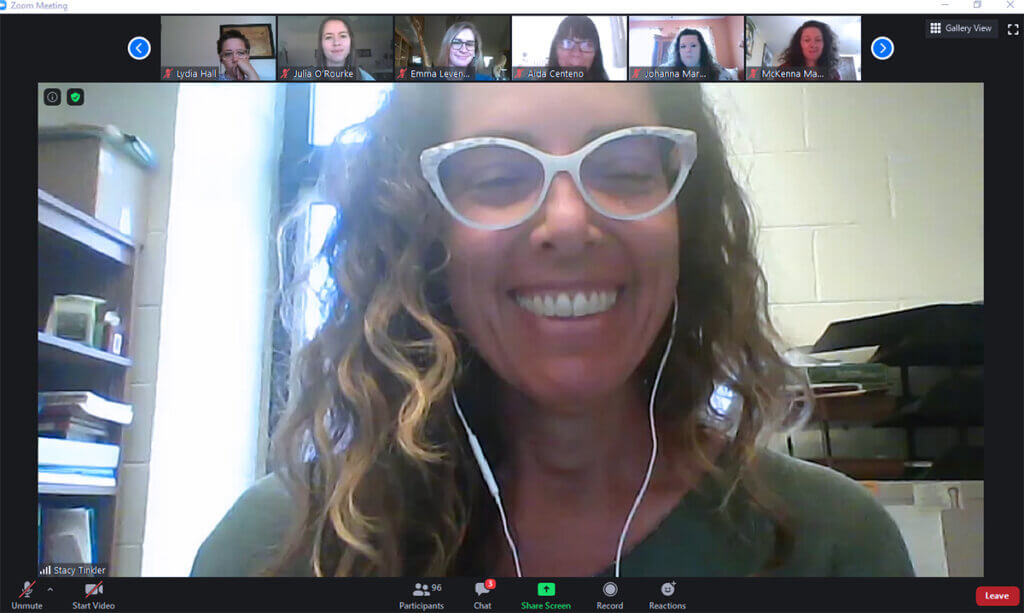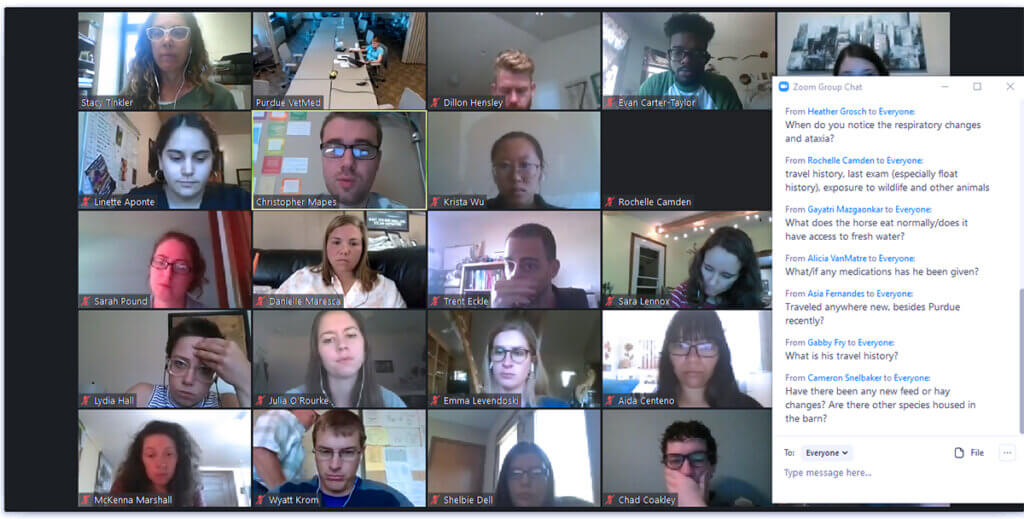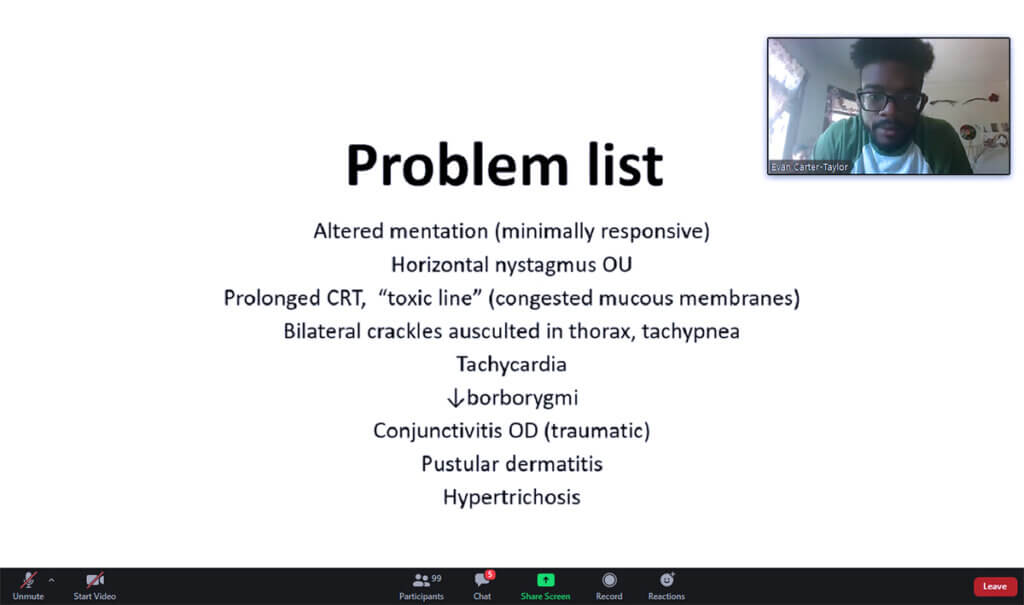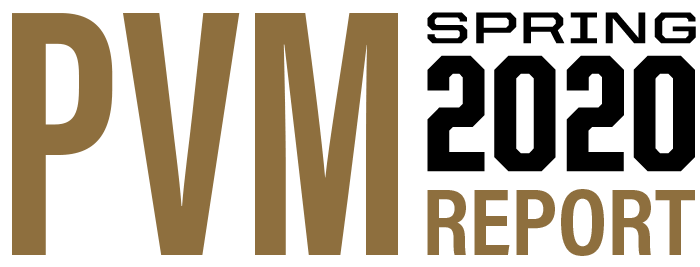The rigor of the veterinary medical curriculum is legendary, and the heritage of face-to-face instruction in classrooms, laboratories, and clinics is cherished. So when COVID-19 reached pandemic status, and Purdue University had to make a sudden change from on-campus classes to online courses, in less than two weeks’ time, faculty and staff faced a more than daunting challenge.
Within the Purdue University College of Veterinary Medicine, work began immediately to convert classes from in-person to remote learning. Dr. Jim Weisman, assistant dean for student affairs and clinical associate professor, said in the DVM curriculum a total of 37 courses were transitioned to virtual formats for students in years 1-3, along with 21 Veterinary Nursing courses, ten graduate student classes, and one pre-vet course.
“The transition of courses to online from their in-person presentation yielded a new set of opportunities for everyone – for the instructor as well as the student,” Dr. Weisman said. “The key for the instructor was to ensure we met the learning objectives for the course even while delivering the content remotely. For lecture courses this was easier to accomplish, but through the use of various media platforms, learning objectives for labs also were able to be met.” What was hardest? “The key was to ensure what was delivered remotely was engaging and allowed the students to actively participate,” Dr. Weisman said.

The Veterinary Nursing Program had an advantage, according to Dr. Pete Bill, interim program director and professor emeritus of basic medical sciences, because of the Veterinary Nursing Distance Learning Program that was put in place some 20 years ago. “We already knew how to set up exams online. We also knew how to utilize remote proctoring of examinations,” Dr. Bill explained. “We knew how to talk students through some of the problems that typically arise from problems like poor connectivity or glitches during online examinations.”
Dr. Bill said the challenge for students involved how quickly things changed. “Students were ‘suddenly’ plunged into a different mode for learning. Because the students must be successful in these courses in order to progress further in the curriculum, the sudden change in modality introduces a different means by which the learning and subsequent testing are conducted,” Dr. Bill said. “Whereas the student has a pretty good idea of how to study and prep for exams in an on-campus setting (having practiced how to do so for years), in the online version the student has to determine ‘how the game is played’ in order to be successful. This creates anxiety. And without having a peer readily available to study with or compare notes on how best to master this new format, the student may be distracted from learning and revert more to just surviving the course.”
However, Dr. Bill said students did adapt. “Like any time something changes in a course that can upset the ‘rules’ by which the student has learned to succeed, there is anxiety until the student has some measure of success (such as passing a quiz or completing a homework assignment). Once success has been attained in some way, the anxiety lessens and the students settle in.”
Another challenge involved the change in learning environments as students moved back home to continue their classes remotely. “Students fail to realize how protected they are from many life pressures while on a campus…. and that once they are home, they may not have a peer support system to help sustain them, and in some cases people in the household are antagonistic to the time the student spends on academic learning,” Dr. Bill said. “While on campus, students are immersed in an environment with peers who roughly have the same priorities – getting an education. While at home, there may be no one who has that same goal and all of the demands and pressures from family or friends to do other things compete and serve to erode the self-discipline needed to be successful with a full load of classes.”
Faculty and staff did everything they could to set the students up for success. Dr. Bill noted that each course instructor adapted using different means, from Zoom meetings to BoilerCast presentations. He said 24 to 30 credit hours of on-campus classes were affected for veterinary nursing students in the three years of the professional program.

The transition also affected veterinary nursing students’ hospital rotations, which had to be truncated or terminated after spring break. “AVMA Committee on Veterinary Technician Education and Activities accreditation mandates that all veterinary nursing students graduating from an accredited Vet Tech/Vet Nursing program will have performed 225-plus specific essential skills to a set level of competency, and that the program shall document acquisition of each of those skills,” Dr. Bill explained. “Students finishing their last semester before graduating needed to get their essential skills done in order to graduate in August. The few that didn’t complete all of their required skills will have to return to campus in late August to complete them to still be awarded their AAS degree in August.”
Clinical instruction for fourth-year students in the DVM program also was affected. “Blocks 16 and 17, which amounted to six weeks, of fourth-year clinics were transitioned to online rounds and case reviews,” explained Dr. Weisman. “Clinicians worked quickly to convert to online clinics. Students had both topic specific rounds, in which they discussed specific diseases, as well as rounds about the patients which were coming into the Purdue Veterinary Hospital. These rounds would total from two to four hours, or at times more, in a day.”
Dr. Weisman said the reaction to the courses’ online transition was very student dependent, but some enjoyed the ability to watch lectures at their pace and be able to go back and re-listen to ensure they got the point. As for the students’ success in adapting, Dr. Weisman said, “Most did very well, but we did hear from students that they missed the community. For some there were issues of adapting to a self-driven schedule but most quickly adapted and appreciated the independence.”
Drs. Brooke and Brent Unruh, of the DVM Class of 2020, were among the students who had to finish their final year of veterinary school virtually instead of in the clinics. They said it was helpful that they were able to start doing online learning at the beginning of a new rotation, rather than in the middle of one. “It was definitely different than what we had become accustomed to with our in-clinic learning and schedule,” Brooke noted. But Brent said the transition to online learning from in-person clinics went smoothly, despite the short time the clinicians had to develop a plan to provide the students with useful virtual rounds.
Brent’s last block was Small Animal Orthopedic Surgery. “On those surgery blocks, you would typically get to see the patient before surgery, watch the surgery, and then provide the post-operative care. Nothing can replace that experience,” Brent said. “However, the rounds provided by the clinicians gave a good overview of what was being done with the in-patients and why those decisions were being made.” Brooke added, “It was also challenging to learn a new routine for participating with online rounds and completion of different assignments, as some of those things were difficult without the in-person aspect.”

Both Brooke and Brent expressed appreciation for all the work the clinicians did and their openness in communicating with students. “I think the biggest key to my success with moving to online learning for my last two rotations was the effort that my senior clinicians put into helping us accomplish the most we could through this type of learning, as well as their understanding that no one knew what this was going to look like,” Brooked explained. “It helped that they were willing to work through the challenges of moving our learning to an online format.” Brent added, “The biggest key to success with online learning was the open line of communication with our clinicians and being able to talk with them about what was working with virtual learning and what we thought might work better. The clinicians’ openness to these ideas and conversations played a large role in the success of the transition to virtual learning.”
Overall, Purdue University moved 5,000 courses online by March 23, which was the Monday after spring break, when students began attending class virtually. That was just 13 days after President Mitch Daniels asked the faculty to make the conversion.
“The idea of transitioning a residential campus experience for nearly 45,000 students to remote learning in a semester or even a year seems an audacious, almost unreachable goal,” Purdue Provost Jay Ackridge said in a message to the Purdue community. “But to make that happen in two weeks?! No matter the enormity of the task, our faculty, staff, and graduate student TAs quickly developed innovative approaches to remote learning… For many of you, much of that work happened during spring break, and the sacrifices you made are deeply appreciated. With your efforts, and support of the Innovative Learning team, ITaP (Information Technology at Purdue), and the Center for Instructional Excellence, an academic miracle was made possible.”
Now under the banner “Protect Purdue,” the next ambitious undertaking is underway, as the university prepares for a safe return to on-campus instruction for the fall semester, guided by the “Protect Purdue Pledge,” by which members of the Boilermaker community each commit to take extraordinary steps to stay well and persistently protect each other. Click here for information about supporting the university though the Protect Purdue Initiative.

